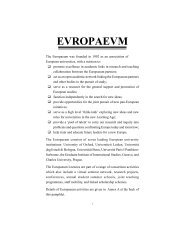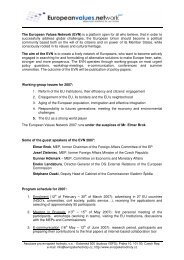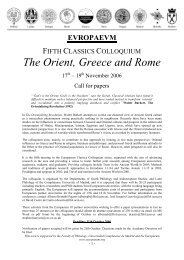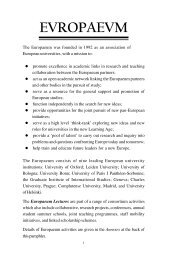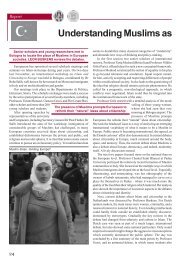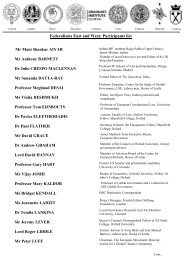Authors Iain Begg | Gabriel Glöckler | Anke Hassel ... - The Europaeum
Authors Iain Begg | Gabriel Glöckler | Anke Hassel ... - The Europaeum
Authors Iain Begg | Gabriel Glöckler | Anke Hassel ... - The Europaeum
You also want an ePaper? Increase the reach of your titles
YUMPU automatically turns print PDFs into web optimized ePapers that Google loves.
Target financial stability<br />
<strong>The</strong> EMU architecture was designed with the objective of safeguarding<br />
price stability in the Eurozone, leaving financial stability aside. After a<br />
long period of excess financial liquidity flowing in and out of European<br />
financial markets, asset price inflation, imprudent accumulation of<br />
financial risks and over reliance of financial institutions on leverage, this<br />
omission invites renewed interest.<br />
While the euro has crucially contributed to economic and financial<br />
stability, 1 financial stability as such has been absent from the<br />
macroeconomic models used by the ESCB, and EU central banks in<br />
general. Several economists and institutions, including the Bank for<br />
International Settlements, have long proposed the need for central banks<br />
to target asset price inflation as well, with an eye on preventing asset price<br />
bubbles. Moreover, as Paul de Grauwe suggests, since financial stability<br />
today also depends on avoiding deep recessions, stabilising the business<br />
cycle should also be of concern to the central bank. 2 This might be<br />
departing from the Maastricht-prescribed exclusive ECB focus on<br />
monetary stability, a field where the ECB has so far demonstrated success.<br />
Recent financial developments, however, have shown that a narrow<br />
definition of central bank success as confined to price stability is not<br />
enough. <strong>The</strong>re is a case to be made for the ECB and other central banks to<br />
follow financial sector asset price movements more closely.<br />
<strong>The</strong> “regulatory philosophy” applied on the eve of the crisis has been<br />
shown to be wrong: a systemic crisis can still occur even if bank supervisors<br />
ensured individual banks were safe. <strong>The</strong>re is now a shift in emphasis from<br />
micro to macro-prudential regulation, focusing on systemic stability. 3 <strong>The</strong><br />
de Larosière Group 4 has recommended setting up a European Systemic<br />
Risk Council (ESRC), under the ECB, comprising EU-level committees of<br />
financial and banking supervisors and the Commission, with the task of<br />
gathering information on all macro-prudential risks in the EU, and<br />
working closely with the IMF, the Financial Stability Forum and G20 at a<br />
global level. In late September 2009 the Commission proposed the<br />
creation of a European Systemic Risk Board (ESRB) along the lines<br />
recommended by de Larosière.<br />
Some believe it is time to revise the Treaty of the EU, to grant supervisory<br />
authority and formal lender of last resort capability to the ECB, the only<br />
institution in the Eurozone able to issue unlimited amounts of a global<br />
reserve currency. Article 105.6 of the EU Treaty provides the possibility of<br />
transferring Eurozone financial supervision (except for the insurance<br />
32<br />
After the crisis: A new socio-economic settlement for the EU




